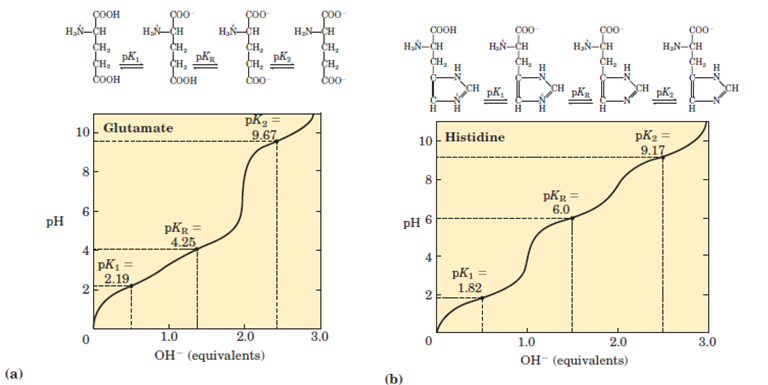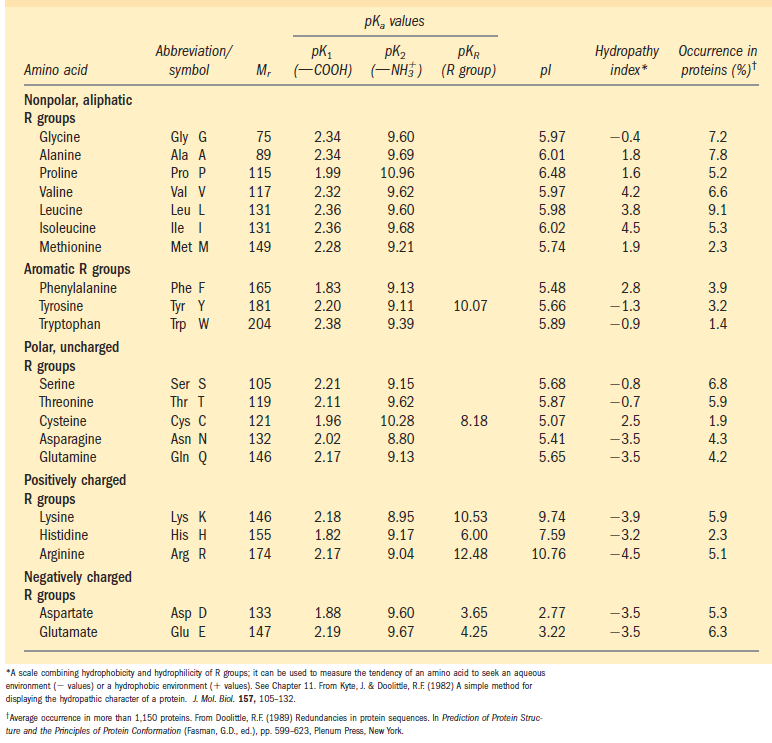
Amino Acids Differ in Their Acid-Base Properties
 المؤلف:
David L. Nelson, Michael M. Cox
المؤلف:
David L. Nelson, Michael M. Cox
 المصدر:
Book or Source : Lehninger Principles of Biochemistry 6th ed 2012
المصدر:
Book or Source : Lehninger Principles of Biochemistry 6th ed 2012
 الجزء والصفحة:
p 84
الجزء والصفحة:
p 84
 6-4-2017
6-4-2017
 3637
3637
Amino Acids Differ in Their Acid-Base Properties
The shared properties of many amino acids permit some simplifying generalizations about their acid-base behaviors. First, all amino acids with a single α-amino group, a single α-carboxyl group, and an R group that does not ionize have titration curves resembling that of glycine. These amino acids have very similar, although not identical, pKa values: pKa of the –COOH group in the range of 1.8 to 2.4, and pKa of the –NH3 group in the range of 8.8 to 11.0 (Table 1.1). Second, amino acids with an ionizable R group have more complex titration curves, with three stages corresponding to the three possible ionization steps; thus they have three pKa values. The additional stage for the titration of the ionizable R group merges to some extent with the other two. The titration curves for two amino acids of this type, glutamate and histidine, are shown in Figure 1.1. The isoelectric points reflect the nature of the ionizing R groups present. For example, glutamate

FIGURE 1.1 Titration curves for (a) glutamate and (b) histidine. The pKa of the R group is designated here as pKR.
has a pI of 3.22, considerably lower than that of glycine. This is due to the presence of two carboxyl groups, which, at the average of their pKa values (3.22), contribute a net charge of -1 that balances the +1 contributed by the amino group. Similarly, the pI of histidine, with two groups that are positively charged when protonated, is 7.59 (the average of the pKa values of the amino and imidazole groups), much higher than that of glycine. Finally, as pointed out earlier, under the general condition of free and open exposure to the aqueous environment, only histidine has an R group (pKa = 6.0) providing significant buffering power near the neutral pH usually found in the intracellular and extracellular fluids of most animals and bacteria (Table 1.1).
TABLE 1.1 Properties and Conventions Associated with the Common Amino Acids Found in Proteins

 الاكثر قراءة في مواضيع عامة في الكيمياء الحياتية
الاكثر قراءة في مواضيع عامة في الكيمياء الحياتية
 اخر الاخبار
اخر الاخبار
اخبار العتبة العباسية المقدسة


